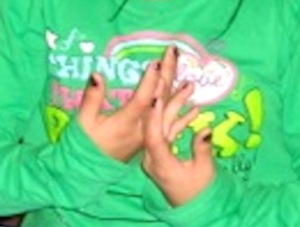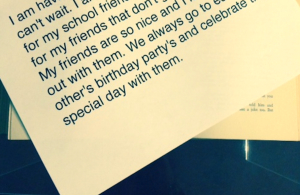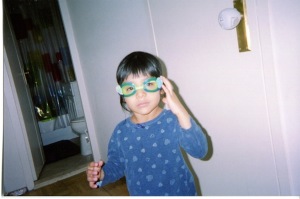MY DAUGHTER, Alma, is 12 now. She spent her first year in Guatemala, living with a foster family. While my husband and I were busy completing the process to adopt her, including filling out many forms, being interviewed, fingerprinted, and waiting, we provided the family with financial assistance.
During that first year, Alma heard only Spanish spoken (no English) and, as far as we know, wasn’t being shown books or being read to, since books are a big luxury in Guatemala, and we were instructed by our adoption attorneys to supply money only for Alma’s food and doctor’s appointments. From afar, I already loved her so much, and I couldn’t wait to bring her home.
We’d been told we’d be able to bring Alma home with us to New York City when she was six months old, but due to Guatemala’s bureaucracy and changing adoption laws, we weren’t able to bring her home until she was a year old. One of the first things we did with her was to speak to her constantly in English, so those sounds would become familiar to her. (Neither John nor I are fluent in Spanish.) We read aloud to her from picture books and showed her pictures and texts, determined to make up for those first 12 months when she’d most likely never seen a book. She appeared to love books from the get-go, and she spoke fairly quickly, calling me “Mama,” and building her vocabulary. Her early developmental milestones were all met on time.
 Around age three, her behavior changed when I read to her. Instead of sitting quietly by my side, looking at the books with me, she immediately jumped up when I opened to the first page, and began acting out the stories, running and dancing hither and thither, acting out the characters, sometimes humming softly to accompany my words. She showed no interest in the text and pictures, and seemed instead to be responding to my voice, making up dances and songs to match my story. I imagined that maybe she’d grow up to be an actress or singer, but I never worried about her lack of interest in the book, itself, as an object to be perused. She was alert, bright, connected, and very curious about the world around her. Looking back, we’ll never know if all that acting out, coupled with her fairly late introduction to books and the English language, was a harbinger of her reading difficulties to come.
Around age three, her behavior changed when I read to her. Instead of sitting quietly by my side, looking at the books with me, she immediately jumped up when I opened to the first page, and began acting out the stories, running and dancing hither and thither, acting out the characters, sometimes humming softly to accompany my words. She showed no interest in the text and pictures, and seemed instead to be responding to my voice, making up dances and songs to match my story. I imagined that maybe she’d grow up to be an actress or singer, but I never worried about her lack of interest in the book, itself, as an object to be perused. She was alert, bright, connected, and very curious about the world around her. Looking back, we’ll never know if all that acting out, coupled with her fairly late introduction to books and the English language, was a harbinger of her reading difficulties to come.
In pre-school, her teachers spoke glowingly of her: “She’s the most popular girl in class.” And then they’d often add, “There’s one thing … sometimes during reading circle she gets up and walks around the room. But if we call on her, she always knows the correct answer.” I smiled, thinking, yes, that’s my girl, always up and active when being read to.
In Kindergarten, at the neighborhood public school we were then sending her to, we once again heard glowing reports of her intelligence and joyful personality. She was able to write her name, both first and last, and could recite the alphabet three times fast in a row. No one had any worries about her.
~
In first grade, something curious began to happen. She began to “lose” her homework and schoolwork. She forgot to turn in assignments, and compositions she wrote in school about her summer vacation and her favorite animal were never found. Her teacher told us about these things, but appeared unperturbed. During parent-teacher conferences, he assured us that she was a bright girl. But on the last day of school, as John and I were standing in the hall, the teacher walked by. As he passed us he said, under his breath, “Maybe you should have Alma tested.”
We were dumbfounded. “Huh? Tested for what?” we asked. We were clueless about what he meant, but he was already down the hall, descending the staircase. We’d long heard that this teacher was acutely uncomfortable with parents, especially when discussing anything that could be construed negatively. Eventually, that summer, after talking to a bunch of people, we figured out that he’d meant we should have Alma tested for a learning disability. But why, we wondered. He’d told us Alma was doing fine. True, she’d become disorganized and was far more interested in sewing, drawing, and making Model Magic sculptures than reading. But that was okay; although we were voracious readers, she didn’t need to be. One of the most interesting parts of parenting is watching your child become her own person, separate from you. As a writer, although it was painful, I began letting go of fantasies of snuggling with her, reading aloud to each other, delighting in sharing the written word.
 At the beginning of the next school year, when Alma entered the second grade, we approached the school guidance counselor. “Should we have her tested?” we asked, still unsure about what would be involved and what it meant. “No,” she answered earnestly, leaning toward us over her desk. “Alma’s smart and she’s doing just fine in school.”
At the beginning of the next school year, when Alma entered the second grade, we approached the school guidance counselor. “Should we have her tested?” we asked, still unsure about what would be involved and what it meant. “No,” she answered earnestly, leaning toward us over her desk. “Alma’s smart and she’s doing just fine in school.”
Alma’s new teacher was the opposite of warm and fuzzy. During our first parent-teacher conference, sounding irritated, she said, “When I gave the class a writing assignment the other day, Alma didn’t write a word, but drew a flower, instead!” It wasn’t like Alma to deliberately ignore instructions, but when we got home and asked her why she’d done that, she couldn’t, or wouldn’t, tell us why.
She did, however, come home with stories about a girl named Madeline, who was pushing her, breaking her things, and stealing her lunch every day. We knew who Madeline was — a very intimidating looking girl with short, spiked hair, twice as big as Alma. Alma said Madeline tailed her all day and made fun of her, calling her names, including “stupid.” The kicker was that Madeline had been assigned the seat next to Alma’s in class. “I really am stupid,” Alma told us, tearfully. “Madeline’s right. I’ll never be a good reader.” We assured her she wasn’t stupid, reminding her of all the things she excelled at, such as visual art, singing, and athletics, but she remained distraught.
The next step, clearly, was for John and me to see her teacher. “Madeline is bullying Alma,” we told her.
“Oh, that’s Madeline, ” the teacher said, breezily, smiling. “She’s a ringleader.”
I was stunned. Wasn’t the school supposed to have zero tolerance for bullies? “Can’t something be done about it?”
The teacher shrugged. “We’ll see.”
“Can you at least change their seats?” I asked, increasingly confused by her reaction.
Changing the subject, she said, “Alma’s reading and writing are really poor. I think I’m going to leave her back and have her repeat second grade next year. I can’t help her.”
“But what would that do, other than humiliate her?” I asked, not adding that if she was so ill-equipped to teach Alma, my beautiful, black haired, brown eyed daughter, how would another year with another most likely equally ill-equipped teacher help Alma? And would she end up in a classroom filled with much younger kids, and kids with behavior problems, who might frighten and distract her?
Madeline continued her bullying. According to Alma, Madeline’s seat was never changed. When I told my therapist what was going on, all she said was, “Sounds like the teacher identifies with the bully, not with Alma.”
It was the middle of the year, and John and I tried to have Alma moved to a different class, to no avail. We then decided that we quickly needed to move her to another school, despite the fact that it was in the midst of the school year. We weren’t zoned for any other public schools, and besides, what would they be able to do differently? We were financially strapped, and a private school would be expensive, but that’s where we decided to look anyway — in the private realm — where we hoped that bullying wouldn’t be tolerated, and with teachers that might be more sensitive to a kid like Alma. We’d proudly identified as a public school family, but that might need to change. However, none of the private schools we looked at had openings.
Finally, we found a private school, which I’ll call Z-School, with an opening. A “democratic free school” (free only in philosophy), Z-School is modeled on Summerhill in Britain, whose philosophy is that the children in many ways “direct” the school. The belief is that children learn best when they’re free from coercion. Pupils can choose which classes, if any, they attend, and are free to choose what to do with their time. John and I met with the principal and were completely swept up by his words. It sounded fantastic for a girl who had trouble reading, we thought. Where better for her to learn on her own time, in her own way?
~
On one of Alma’s last days in public school, I passed by the school principal, who knew she was leaving. “Sorry we failed you,” he said, not sounding sorry at all. The John and I had I’d heard a rumor was that public schools didn’t want children like Alma in their schools, because they brought the school’s scores down. The schools’ scores were based on the students’ performance and the overall improvement of those scores over time. Schools with low scores received lower ranking from the City.
Alma enrolled in Z-School mid-semester. On the first day of school, she returned home with an enormous, ugly gash across her chest. The school had gone to the local park, and Alma had climbed and fallen from a high fence, and there were no teachers nearby monitoring the children. I worried that we’d made a grave mistake. Over the next few months, however, Alma seemed happy, so unlike how she’d been in public school, and that was worth the tuition, we reasoned.
We met with her teachers a few times at Z-School, and asked them to focus on helping Alma with her reading. “Obviously not by coercion,” we told them, assuring them that we understood the school’s philosophy, “but however you can do it.” They promised they would.
At the end of the semester, we received a long written report rather than a graded report card, which struck us as a very humane way to go about things: Who needed arbitrary grades? The report spoke of Alma’s cute and funky clothing style, her vivacious personality, and how she appeared to have a crush on a boy in her grade. There wasn’t a single word about academics, but we didn’t worry about that because she’d only been there for a few months, and she was happy.
The next year, at the end of third grade, we received yet another report about Alma’s great personality and artistic talent. When we asked about her academics, her head teacher said, “Well, she chose not to attend classes. She played a lot with her friends, and children learn just as much from play as classroom learning.”
John and I were stunned. We stared at each other, speechless. Alma had led us to believe that she was at least attending math and English classes, although to be fair, she’d never actually come out and directly said so. And since there were no homework or tests, we couldn’t rely on those to monitor her.
John and I felt betrayed by the school. Although we’d initially been swept up by the school’s philosophy, we no longer were. Not a single class, ever? This didn’t seem right for a kid like Alma. Maybe Z-School was perfect for self-motivated kids with no academic issues. Maybe Alma needed more structure, after all. But where could she go?
 “It’s time to have her tested,” we told each other, despite the guidance counselor’s advice when Alma was in second grade. Alma would need to have a neuro-psychological evaluation given by a licensed psychologist in order to determine if she had a reading disability and needed to receive special education services. This was very expensive. John and I were interviewed by the neuro-psychologist and completed several questionnaires about Alma and us. Alma then met with the evaluator three times, during which she was given a battery of psychological and educational tests to determine her specific educational needs, and to develop a diagnosis and educational plan. The evaluator wore a scowl and was brusque with John and me, and we found her depressing, but she was warm with Alma, who liked her.
“It’s time to have her tested,” we told each other, despite the guidance counselor’s advice when Alma was in second grade. Alma would need to have a neuro-psychological evaluation given by a licensed psychologist in order to determine if she had a reading disability and needed to receive special education services. This was very expensive. John and I were interviewed by the neuro-psychologist and completed several questionnaires about Alma and us. Alma then met with the evaluator three times, during which she was given a battery of psychological and educational tests to determine her specific educational needs, and to develop a diagnosis and educational plan. The evaluator wore a scowl and was brusque with John and me, and we found her depressing, but she was warm with Alma, who liked her.
The tests revealed that Alma has dyslexia, which is the name for specific reading difficulties with accurate word recognition, decoding, and spelling. It’s neurological and often genetic. We wondered if her birth parents had dyslexia, but unfortunately, we knew next to nothing about them, and probably would never be able to find out. We also learned that many people have overcome dyslexia to do great things, such as Albert Einstein, Harry Belafonte, Thomas Edison, and cartoonist Jules Feiffer. We were sure that a girl as gifted as Alma could join their ranks in overcoming her disability.
~
It was already summer, and we needed to find a new school once again, where she’d receive instruction geared specifically to children with dyslexia. This was a whole new world for us. We did extensive research and came up with five or six schools that used the Orton-Gillingham method of teaching reading, which focuses on teaching children how to sound out and identify words and how to spell them. Highly structured and systematic, it engages all the senses (for instance, a child taps each finger to her thumb as she spells out a word).
Such schools are expensive, way more than even the toniest private schools in the city. Only one of them had an opening this late in the summer – the D-School, I’ll call it, located in Manhattan. To our relief, Alma was interviewed and accepted. “I’m glad to leave Z-School,” she told us. “It’s for kids who don’t fit in anywhere else.” We were surprised by her perception of the school, but it made us even more determined that she attend D-School, where, during her first semester, she did receive Orton-Gillingham instruction, as we’d hoped. But her needs were not as extensive as most of the other children in her grade, who had severe language delays and behavioral issues, and in some cases, appeared to be on the autism spectrum. We had worried about her being around kids with behavioral issues in public school, and now here we were. Alma tended to get lost in that environment, and it was difficult for her to make friends. The other children often had meltdowns, and some had problems communicating. Alma spent most of her time with her teachers.
 She remained at D-School for two years, where her strengths did emerge — particularly that she’s a visual learner, and images, color, and other visual media help her to learn. In the meantime, there were still no openings in the schools we most coveted. Alma’s reading didn’t improve much, and her self-esteem was still low. In addition, now began our battles with the NYC Department of Education (DOE) to help us offset the cost of the school. In order to receive special educational services in a NYC public school, the Committee on Special Education, which includes educators and psychologists, reviews the neuro-psychological evaluation, the child’s previous educational performance, interviews the child, and observes her in the classroom. The Committee then makes its own recommendation about the child’s academic/educational placement — i.e., whether the public schools can meet her needs or not.
She remained at D-School for two years, where her strengths did emerge — particularly that she’s a visual learner, and images, color, and other visual media help her to learn. In the meantime, there were still no openings in the schools we most coveted. Alma’s reading didn’t improve much, and her self-esteem was still low. In addition, now began our battles with the NYC Department of Education (DOE) to help us offset the cost of the school. In order to receive special educational services in a NYC public school, the Committee on Special Education, which includes educators and psychologists, reviews the neuro-psychological evaluation, the child’s previous educational performance, interviews the child, and observes her in the classroom. The Committee then makes its own recommendation about the child’s academic/educational placement — i.e., whether the public schools can meet her needs or not.
If the parents disagree with the Committee’s decision, they can challenge it, and ask for reimbursement from the City and State to send their child to a special school, on the grounds that the public schools can’t provide the necessary help. If the Committee still disagrees, the parents can take their case to a hearing, with the help of expensive legal counsel. The system is daunting and overwhelming, like a Catch-22 of decisions and appeals. Of course, if parents have the means, they can pay out of pocket and bypass all of this.
After dealing with all the required paperwork and meetings, including visits to public school, submitting various documentation — such as report cards, and questionnaires filled out by teachers — the DOE paid 70 % of Alma’s tuition for the first year. The decision was based solely on a technicality related to their failure to meet certain legally required deadlines.
But in Year 2, after all the same paperwork, the committee didn’t support Alma continuing at D-School, but instead recommended a regular classroom with some extra services in the public school. We appealed, and went to a hearing, which was excruciating. The City’s attorney hammered away at us, trying to demonstrate that Alma didn’t require a special school. The Impartial Hearing Officer (the actual title) decided in our favor — that the public school recommended for Alma would not be suitable for her — and we were elated. However, the DOE then appealed to the State, and we lost, and had to cover full tuition. As long as Alma attends special schools, this is a battle we’ll have to face every year.
Toward the end of fifth grade, Alma’s teachers urged John and me to take her out of D-school. “She needs to be with peers, less impaired, in order to blossom and learn.” We agreed with them, and they suggested we apply to the schools we’d investigated before, and this time, most of them had openings.
We hired a consultant to help us to navigate the tricky world of applying to special schools. Consultancy of this sort turned out to be big business in New York. We had our eye on one school in particular: L-School, let’s call it. It was considered the best for dyslexia in the city, and its children fit Alma’s profile, “very bright children with reading disabilities.” About L-School, the consultant said, running her fingers through her shoulder-length, curly red hair, “Don’t even try there. It’s more competitive and more difficult to get into than Harvard.”
We applied to L-School, anyway, attending a meeting there for prospective parents, at which the Admissions Counselor warned all of us kindly that we shouldn’t get our hopes up. “At this point, there aren’t any openings in the sixth grade.”
When Alma was called for an interview, we were amazed and grateful. When she was accepted a month later, the three of us were over the moon. Two slots had opened up, and Alma had gotten one of them. Alma jumped up and down and hugged me when I told her the news.
L-School, however, was as expensive as D-School. Somehow, once again, we found the money, using credit cards. And once again, we set out to do battle with the DOE. This time, the DOE recommended her for a fifth grade class in the public schools, even though she’d already completed fifth grade. We appealed the decision, based on the inappropriate placement decision, and the DOE paid the full amount at L-School. We were thrilled and relieved.
 Alma is thriving at L-School, and we plan to keep her there through high school. She practices her decoding and comprehension skills every day, and happily spends time with the other children in her grade. She’s also learning self-advocacy, which she will need as she grows — to tell college professors that she’s a visual learner, to ask for extra time for tests, to inform a boss that she may need some assistance. John and I believe she will grow and blossom, if not into a person who adores reading as we do, at least into someone who’s comfortable with books and language, and who will find her own way in our complicated world.
Alma is thriving at L-School, and we plan to keep her there through high school. She practices her decoding and comprehension skills every day, and happily spends time with the other children in her grade. She’s also learning self-advocacy, which she will need as she grows — to tell college professors that she’s a visual learner, to ask for extra time for tests, to inform a boss that she may need some assistance. John and I believe she will grow and blossom, if not into a person who adores reading as we do, at least into someone who’s comfortable with books and language, and who will find her own way in our complicated world.




